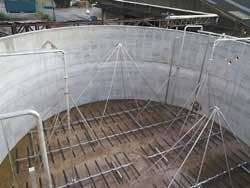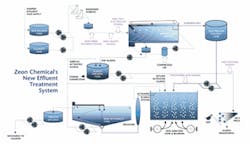Research results in 60% COD reduction in latex effluent
By Anthony Bennett
ACWa treatability study helps UK latex manufacturer improve quality and reduce toxicity of its discharged effluent.
Latex manufacturer Zeon Chemicals Europe Ltd has awarded a US$ 1.7-million turnkey contract to ACWa Services Ltd. to extend its effluent treatment system in Sully, UK. ACWa's system design is based on their extensive site treatability study. This demonstrated that a 50% to 60% reduction in the chemical oxygen demand (COD) of the latex effluent could be achieved by installing an activated sludge system, modifying feed supply equipment and updating the dissolved air flotation (DAF) system. ACWa's plant will significantly improve quality and reduce toxicity of the effluent discharged into the local watercourse.
The new system comprises a fully automated secondary treatment activated sludge system including aeration, degassing, settlement and sludge dewatering. This system is fed from Zeon's existing primary treatment DAF system. The chemical dosing associated with the existing DAF system is to be fully automated to improve DAF operating efficiency. The feed flow-balancing capacity will be increased to provide a homogenous feed to the DAF system. Combined primary and secondary sludge will be stored and a belt press used for dewatering.
ACWa is implementing recommendations from the treatability study to optimise the operation of the DAF system. Raw effluent will be diverted when pH, flow or load is beyond the existing work's design parameters. New run down screens will be installed to remove gross latex solids present in the raw effluent. A new balance tank will provide 12 hours hydraulic retention time for smoothing out loading variations. A new mixer and spray system will reduce foam build up in the tank.
DAF feed pumps will have inverter drives to allow flow control into the DAF system. Ferric chloride, caustic and polyelectrolyte dosing up-stream of the DAF plant will be automated. DAF modifications will provide an averaged flow to secondary treatment.
DAF supernatant enters an existing transfer tank from where new pumps will transfer it to the completely mixed activated sludge aeration tank, with air supplied through fine bubble diffusers. The effluent was deficient in phosphorous in the treatability study. Therefore, phosphoric acid is dosed into the transfer flow to provide micro-organisms with the essential phosphorous nutrient.
A dissolved oxygen (DO) monitor will be used via the control system to control the DO in the aeration tank at two mg/l. The resulting "mixed liquor" suspended solids (MLSS) is expected to be 3,500 to 4,500 mg/l. An MLSS monitor is included to trend suspended solids via the software control and data acquisition (SCADA) system to allow optimisation.
Mixed liquor from the aerobic stage gravitates via a degassing column into a settlement tank. Degassing is included to enhance settlement characteristics, solids being removed from the base of the settlement tank with clarified treated effluent gravitating over a peripheral launder. Solids collected at the base of this tank are normally returned to aeration as return activated sludge (RAS). Periodically, surplus activated sludge (SAS) will be diverted to the sludge holding tank. The amount of SAS wasted will be determined by calculating the sludge yield from the system. The treatability study determined this yield to be 0.15 to 0.25 kg dry solids sludge produced per kg COD treated.
Monitoring of the treated effluent will be undertaken in the new collection tank. Treated effluent will be discharged to the lagoon.
Combined primary and secondary sludge is stored in a new sludge holding tank fitted with decanter facilities to enable excess water to be removed. Decanted sludge is further dewatered using a new belt press. A polymer is dosed into the sludge prior to pressing, so the sludge would be dewatered to 15% - 20 % dry solids before being transferred to a skip for off-site disposal.
Author's note
Anthony Bennett, a water management consultant for Specialist Technical Solutions Limited, is based in Keighley, West Yorkshire, UK. Website: www.specialist-technical-solutions.co.uk


